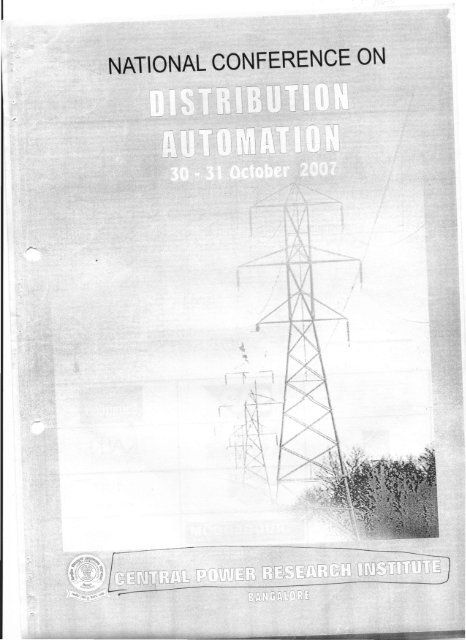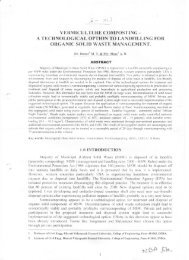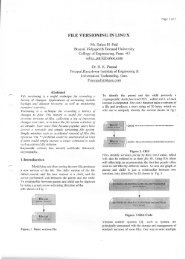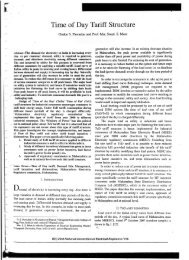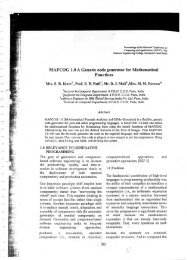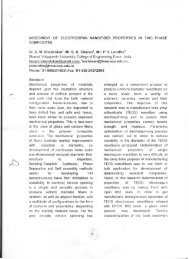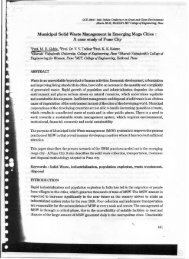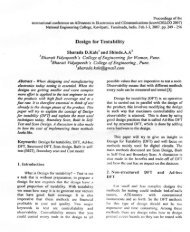IIII •••-- ,.'1_11 - BVU College of Engineering, Pune, India
IIII •••-- ,.'1_11 - BVU College of Engineering, Pune, India
IIII •••-- ,.'1_11 - BVU College of Engineering, Pune, India
You also want an ePaper? Increase the reach of your titles
YUMPU automatically turns print PDFs into web optimized ePapers that Google loves.
NATIONAL CONFERENCE ON<br />
- -=1f:-- -, n~r~<br />
1~--1] IT ~~ ffiH 0
---- Sponsors .----<br />
,.<strong>'1</strong>_<strong>11</strong> <strong>IIII</strong><br />
A K nr.; e, j·uC)!· (nn,p.\r,y<br />
~-.. - -- -- --- ..-....- -=-<br />
- - ~ .<br />
.. -.. -~-<br />
<strong>•••</strong>• k\£ _ <strong>•••</strong>• ..,<br />
-, =....- .. ~<br />
<strong>•••</strong>•• ~ tAIII!W ~<br />
N AGA E<br />
-- <strong>•••</strong><br />
••<br />
EASUN REYROlLE<br />
ORACLE<br />
Co-Sponsors ---<br />
~<br />
GarrenConr<br />
-~*."' •....<br />
KALKI<br />
~:()I\.',\·'t..:..JI::P..TOhl<br />
EC-NOLOGIES<br />
P R D C<br />
J
Sponsor I Cosponsors Pr<strong>of</strong>ile<br />
Technical Sessions<br />
Contents<br />
I - Substation Automation and Integration<br />
1. IEC 61850: Role <strong>of</strong> Conformance Testing in Successful Integration<br />
Eric A. Udren, Willem Strabbing, Dave Dolezilek<br />
KEMA Consulting - USA KEMA Consulting Netherlands<br />
Schweitzer <strong>Engineering</strong> Laboratories - USA<br />
2. Requirements <strong>of</strong> Interoperability and Communication Redundancy In IEC<br />
61850 based SA Systems<br />
Rajiv Krishnan, ABB Limited, Bangalore<br />
3. IEC 61850 Standards in Substation Automation<br />
G Krishnamurthy Kerur, Easun Reyrolle Ltd, Bangalore<br />
4. Modular Concept For Protection & Substation Automation For lee 61850<br />
Based Ehv Substations<br />
Kuldeep Tickoo, Bhupendra Badiya, Siemens - <strong>India</strong><br />
5. Advanced Substation Automation: An Overview<br />
Dr. R. P. Gupta, Distribution Automation Research Centre, CG Global R &<br />
D Centre, Crompton Greaves Ltd., Mumbai - 400 042, <strong>India</strong><br />
6. Planning for the Successful Integration <strong>of</strong> Substation Communications<br />
J.M Shaw, Garret/Com, Inc.<br />
7. IEC 61850 Substation LAN - Issues to Consider when Designing and<br />
Deploying Ethernet<br />
Networks<br />
Roger Moore, and Rene Midence, RuggedCom<br />
II - Control Centre<br />
8. Control Center Design Today<br />
Dr. Michael Wolf, PSI CNI GmbH, Germany<br />
9. Human-Machine Interface for Large-Scale Distribution Management<br />
Systems<br />
Dr. Michael Wolf<br />
lOUse <strong>of</strong> Large Screen Displays in Automated Industries -<br />
Broader process views for improved abnormal situation management.<br />
Barco<br />
III- Economics <strong>of</strong> Automation<br />
<strong>11</strong> Cost Justification <strong>of</strong> SCADA/DMS Due to Loss Reduction<br />
Albana <strong>11</strong>0, Roland Eichler and Vikram Gandotra, Siemens <strong>India</strong><br />
12 The Cost <strong>of</strong> Network Control<br />
Dr. Michael Wolf, with PSI CNI GmbH, Germany<br />
13 Innovative Optical Sensor Technology - The Foundation <strong>of</strong> Cost Effective<br />
MVILV Distribution Network Monitoring<br />
James Northcote-Green, Martin Speiermann and Alfred Manohar<br />
Consultant, ABB and PowerSens, UK, PowerSense AlS , Amtech Automation<br />
, Bangalore, <strong>India</strong>
47 Implementation <strong>of</strong> SCADAIEMS System for Distribution System<br />
Automation<br />
P. V.Chopade, D. G.Bharadwaj, Bharati Vidyappeth University <strong>College</strong> <strong>of</strong><br />
<strong>Engineering</strong>, <strong>Pune</strong>, INDIA<br />
48 NDPL Substation Automation Project: Step forward for Automation<br />
integration<br />
Sanjay kumar Banga and Ajay Prashant Biswas, NDPL, New Delhi<br />
49 Omniagate<br />
)
Paper for National Conference on Distribution Automation @CPRI Bangalore<br />
Implementation <strong>of</strong> SCADA/EMS System for<br />
Distribution System Automation<br />
P.V.Chopade Member IEEE,<br />
Abstract- Automation <strong>of</strong> power distribution systems has<br />
increasingly been adopted by power utilities worldwide in<br />
recent years. This is to provide a more reliable supply to its<br />
customers and to enhance operational efficiency. This can<br />
be used for the distribution network <strong>of</strong> about llKV to 25<br />
KV.<br />
SCADA system can be used as an important building block<br />
for automation <strong>of</strong> distribution network. The SCADA system<br />
was commissioned and became operational in mid 1988.<br />
Due to continuous network expansion & increasingly<br />
higher expectations <strong>of</strong> consumer demands for electrical<br />
energy are continuously increasing. So the distribution<br />
system needs continuous upgrading to incorporate more<br />
remote terminal units (RTUs) as well improved functional<br />
enhancements.<br />
In this paper implementation <strong>of</strong> SCADA system in<br />
distribution automation & the benefits through<br />
incorporating such system are presented; along with a case<br />
study for PECO energy company.<br />
Index Terms (Keywords) - seA DA/EMS, Distribution System,<br />
Automation.<br />
I. INTRODUCTION<br />
Electric power is normally generated at <strong>11</strong>-25kV in a power<br />
station. To transmit over long distances, it is then stepped-up<br />
to 400kV. 220kV or 132kV as necessary. Power is carried<br />
through a transmission network <strong>of</strong> high voltage lines.<br />
Usually, these lines run into hundreds <strong>of</strong> kilometers and<br />
deliver the power into a common power pool called the grid.<br />
The grid is connected to load centers (cities) through a subtransmission<br />
network <strong>of</strong> normally 33kV (or sometimes<br />
66kV) lines. These lines terminate into a 33kV (or 66kV)<br />
substation, where the voltage is stepped-down to IlkV for<br />
power distribution to load points through a distribution<br />
network <strong>of</strong> lines at IlkV and lower.<br />
P.V.Chopade is with the Bharati Vidyappeth University <strong>College</strong> <strong>of</strong><br />
<strong>Engineering</strong> ,<strong>Pune</strong>-43, M.S.,INDIA, Member IEEE. ( phone:<br />
+91- 020-24370991: fax +91 020- 24372998'<br />
e-mail: plavinchoml.!~ccl.:.org). ~<br />
D.G.Bharadwaj is Pr<strong>of</strong>essor <strong>of</strong> Electrical <strong>Engineering</strong> Department and<br />
Head <strong>of</strong> Research and Development Cell, Bharati Vidyappeth University<br />
<strong>College</strong> <strong>of</strong> <strong>Engineering</strong> ,<strong>Pune</strong>-43, M.S.,INDIA.<br />
(e-rnail: dattatra\.Mveth.net).<br />
D.G.Bharadwaj<br />
Distribution Automation System (DAS) as a system that<br />
enables an electric utility to remotely monitor, coordinate<br />
and operate distribution components, in a real-time mode<br />
from remote locations. The distribution automation system<br />
is based on an integrated technology, which involves<br />
collecting data and analyzing information to make control<br />
decisions, implementing the appropriate control decisions in<br />
the field, and also verifying that the desired result is<br />
achieved. The location, from where control DA system is<br />
beneficial in day-to-day operation and maintenance <strong>of</strong><br />
distribution network. The other benefits <strong>of</strong> the distribution<br />
automation are: reduced technical and commercial losses,<br />
improved cash flow, lower electric service restoration time,<br />
reduction in equipment damage, better availability <strong>of</strong> system<br />
information, improved operational planning, remote load<br />
control and shedding, and enhanced power quality and<br />
reliability<br />
I!. NEED OF DISTRIBUTION SYSTEM<br />
AUTOMATION [I ][2]<br />
To minimize Distribution Losses:<br />
The demand for electrical energy is ever increasing. Today<br />
over 21% (theft apart!!) <strong>of</strong> the total electrical energy<br />
generated in <strong>India</strong> is lost in transmission (4-6%) and<br />
distribution (15-18%). The electrical power deficit in the<br />
country is currently about 18%. Clearly, reduction in<br />
distribution losses can reduce this deficit significantly. It is<br />
possible to bring down the distribution losses to a 6-8 %<br />
level in <strong>India</strong> with the help <strong>of</strong> newer technological options<br />
(including new technology) in the electrical power<br />
distribution sector which will enable better monitoring and<br />
control.<br />
To minimize voltage sags & interrupts:<br />
In general, medium voltage (MV) power distribution<br />
networks are operated radially, with different levels<br />
distribution automation. Investment in distribution<br />
automation is a technical and an economic optimizations<br />
issue to considered in distribution network design. The<br />
purpose is minimize long term total costs including costs <strong>of</strong><br />
investments, losses, outages and poor power quality within<br />
relevant constraints.<br />
Power quality is <strong>of</strong> increased concern. Previously, long<br />
interruptions have been <strong>of</strong> major interest but nowadays<br />
focus is on shorter interruptions. From the customer point<br />
view, short interruptions and voltage sags affect customer<br />
equipment in the same way. Distribution automation caused<br />
to control the influence <strong>of</strong> interruptions and voltage sags.
Paper for National Conference on Distribution Automation @CPRI Bangalore<br />
Novel solutions <strong>of</strong> distribution automation include, example,<br />
modern, intelligent systems and equipment for fault<br />
isolation and optimized operation and control <strong>of</strong> the<br />
network. From the customers' point <strong>of</strong> view interruptions<br />
and voltage sags have an equally harmful influence on the<br />
operation <strong>of</strong> equipment and processes. An interruption is<br />
defined as the complete loss <strong>of</strong> voltage « 0.1 p.u) and a<br />
voltage sag as a voltage drop to between 0.1 and 0.9 p.u. in<br />
rms voltage [I). Voltage sags can be characterized by<br />
magnitude, duration, and number [2]. The lower the sag<br />
magnitude and/or the longer the sag duration, the higher is<br />
the probability <strong>of</strong> disoperation <strong>of</strong> the customer's equipment.<br />
In radially operated MV networks having circuit breakers<br />
only at the substation, a customer experiences sags caused<br />
by faults in the neighboring MV feeders, while customers<br />
supplied by the faulted feeder will face an interruption. In a<br />
construction with downstream circuit breakers along the<br />
feeders, customers will also experience sags caused by faults<br />
in the neighboring feeders. In this situation, depending on<br />
the relative location <strong>of</strong> the customer and the fault, customers<br />
may also experience interruptions and sags caused by faults<br />
occurring in the same feeder as the customers themselves.<br />
Thus distribution automation is essential to<br />
improve the overall efficiency <strong>of</strong> distribution system by<br />
remotely monitoring the distribution system & facilitating<br />
supervisory control <strong>of</strong> devices and provides decision<br />
support tools to improve the system performance.<br />
<strong>11</strong>1. SCADA {EMS SYSTEM [3] [5]<br />
SCADA system:<br />
The term refers to a large ..scale, distributed measurement<br />
(and control) system. SCADA systems are used to monitor<br />
or to control chemical or transport processes, in municipal<br />
water supply systems, to control electric power generation,<br />
transmission and distribution, gas and oil pipelines, and<br />
other distributed processes.<br />
Basically it includes<br />
I. Data Acquisition (collection) equipment<br />
2. Data transmission telemetric equipment<br />
3. Data monitoring equipment<br />
4. HMI (Human machine interface)<br />
5. Networks ,communication database & s<strong>of</strong>tware's etc.<br />
Communication Between Master Control Station &<br />
Remote Control Station in SCADA system:<br />
SCADA equipments are located in master control centre ,<br />
zonal regional control centers, district control centers ,<br />
control rooms <strong>of</strong> generating stations & large sub-stations.<br />
SCADA requires two way communication channels between<br />
master control centers & remote control centers as shown in<br />
the following diagrams i.e. in figure I & figure 2.<br />
Traditional power communication system is established<br />
mainly for intra-company information exchange. Low<br />
bandwidth and communication isolation hinders large<br />
infonnation exchange and inter-operation. Deregulation<br />
results in horizontal merger and consolidation <strong>of</strong> many<br />
existing utilities. Inter-company communication and<br />
integration <strong>of</strong> data from various control centers, power<br />
plants. and substations. is required.<br />
Figure I : SCADA Communication Unit<br />
2<br />
Figure 2: Remote Control Station in SCADA system<br />
El'iGJNHl(L"I(; .<br />
WOIU\!>,ATlON I<br />
The possibility and inevitability to perform this integration<br />
process will drive all utilities toward the standardization <strong>of</strong><br />
data models and communication ·protocols. Existing<br />
communication tools must be modified or replaced to<br />
accommodate extensive information exchange. Internet<br />
based communication network enables information sharing<br />
and various network applications and provide an ideal<br />
infrastructure for the next generation <strong>of</strong> power<br />
communication network. Various Internet/Intranet<br />
applications are replacing, upgrading, and extending the<br />
existing power communication establishment. Open access<br />
same-time information system (OASIS) is a good example.<br />
Functions <strong>of</strong> SCAD A in Electrical power distribution<br />
system:<br />
Certain functions are basic to electric utility SCADA<br />
systems. The more common functions include:.<br />
I Data Acquisition<br />
2 Information Display<br />
3 Supervisory Control<br />
4 Alarm Processing
Paper for National Conference on Distribution Automation @CPRI Bangalore<br />
5 Information Storage and Reports<br />
6 Sequence <strong>of</strong> Events Acquisition<br />
7 Data Calculations<br />
8 Special RTU Processing/Control<br />
IV. OPERATION OF SCADA IN DISTRIBUTION<br />
SYSTEM AUTOMA nON [7] [ 8] [ 10]<br />
Levels <strong>of</strong> Automation:-<br />
I. Substation Level Automation<br />
2. Feeder level automation<br />
3. Customer level automation.<br />
The distribution system implementing SCADA system It is<br />
shown in figure 3<br />
mv feeders<br />
(DistrituOOn net....nj<br />
Figure 3: SCADA in Distribution System<br />
Polling Schemes:<br />
SCADA systems intended for electric system operations<br />
almost universally use a polling scheme between the central<br />
master and individual RTUs. In communications<br />
engineering parlance the method is known as "Demand<br />
Assignmentffime Division Multiple Access (DArrDMA)."<br />
The master station controls all activity and RTUs respond<br />
only to polling requests.<br />
Figure 4 illustrates the most common communication<br />
arrangement.<br />
Multiple two- or four-wire telephone-grade circuits radiate<br />
from the master. These communication circuits each operate<br />
MASTER STATION L<br />
......-------.-----------' ------,<br />
I \ I<br />
~R~~ f--JI ~R=~ ~<br />
~ w ---\ IRTlJ r<br />
~~<br />
Figure 4. Typical multidrop communication system [7 ]<br />
. in half duplex mode and each operates independently <strong>of</strong><br />
others. One circuit may be dedicated to single RTU, but the<br />
common and economical approach is to multi-drop or partyline<br />
several RTUs from a common communication circuit.<br />
The media for these circuits may be leased telephone<br />
circuits from a common carrier, private microwave. fiber<br />
optic cable systems, two-way cable TV, power line carrier,<br />
or even satellite. Polling and command requests and RTU<br />
responses are time-multiplexed on each circuit. Each circuit<br />
terminating at the master station is independently serviced<br />
on an asynchronous basis by the master station. Information<br />
rates per channel may range from 300 to 9600 bit& and are<br />
largely influenced by the measurement point count<br />
serviced by all RTUs sharing a common circuit. The most<br />
commonly used information rate is 1200 bit& using<br />
asynchronous byte-oriented message formats. The polling<br />
periodicity is established by the necessary response <strong>of</strong> using<br />
application functions and by human factor considerations.<br />
Where acquired data support closed control loops, such as<br />
automatic generation control (AGC), the data sampling rate<br />
must be sufficient to maintain desired control loop response.<br />
For AGC this periodicity generally ranges between 2 and 6<br />
s. For general operator monitoring <strong>of</strong> most system<br />
variables, an update period <strong>of</strong> about 10 s is generally<br />
acknowledged to be sufficient. Rapidly changing least<br />
significant numerals on CRT displays tend to be distracting<br />
to operators. Not all variables need to be acquired at the<br />
same period and, in fact, usually are not. The factor which<br />
usually establishes the basic RTU polling period is the<br />
desired response to unscheduled events or alarms.<br />
For electric system operations this period is on the order <strong>of</strong><br />
2-3s. Other information may be selectively acquired at each<br />
poll period or at multiples <strong>of</strong> the poll period<br />
A variation to fixed period polling is the round robin<br />
approach used by some European systems. Here, each RTUto-master<br />
message contains an end <strong>of</strong> message (EOM).<br />
When the master station detects the EOM the next RTU<br />
sharing the same communication line is then immediately<br />
polled. This results in continuous activity on the line with no<br />
gaps <strong>of</strong> time. The individual point sampling rate is then<br />
influenced by the number <strong>of</strong> RTUs sharing the same line<br />
and the number <strong>of</strong> points per RTU and whether or not<br />
exception reporting is being used. Modern RTUs actually<br />
scan the connected points at a high rate compared to the<br />
master station poll period. When a master station poll<br />
request is received by the RTU, the current values or status<br />
stored in the RTU memory are fetched on a selective basis<br />
3
Paper for National Conference on Distribution Automation @CPRI Bangalore<br />
and transmitted to the master station. Polling requests may<br />
also contain various command and control requests. The<br />
RTU must distinguish these from information requests and<br />
respond accordingly.' A command sequence for circuit<br />
breaker operation is typical. Some form <strong>of</strong> select-checkoperate<br />
sequence is almost always used to avoid<br />
disoperation. SCADA systems intended for distributed data<br />
acquisition and control within a large substation or power<br />
plant may utilize a different polling strategy. Where all<br />
RTUs can be physically located within one or two thousand<br />
feet <strong>of</strong> each other, they may be connected to each other, the<br />
man-machine interface, and a host processor via local area<br />
network. Such arrangements permit great flexibility in<br />
communication between system elements or nodes. Instead<br />
<strong>of</strong> conventional sequential polling under the complete<br />
direction <strong>of</strong> the master station, local area network connected<br />
systems generally permit exchange <strong>of</strong> information directly<br />
between any two nodes on a random basis. Carrier Sense<br />
Multiple Access (CSMA),Token Ring ,or other schemes<br />
may be used. Figure 5 shows a simplified block diagram <strong>of</strong><br />
a distributed system where communication can occur<br />
between any nodes at random basis. Network connected<br />
local SCADA. system where communications can occur<br />
between any nodes on a random basis.<br />
POSSIBLE<br />
HOST<br />
PROCESSOR<br />
DATA<br />
NETWORK<br />
j<br />
I R7U I<br />
Figure 5 : Network Connected to local SCADA<br />
Data Inputs<br />
SCADA systems intended for electric system operations are<br />
most frequently called on to monitor the following<br />
information from substations and power plants:<br />
Substations<br />
bus voltages line flows (MW, MYAR, A) transformer tap<br />
positions circuit breaker, switch, other device status alarms<br />
MW sequence-<strong>of</strong> events. unit generation MW and MY AR<br />
auxiliaries MW and MY AR unit MWh auxiliaries MWh<br />
station net MW, M'YAR unit maximum and control limits<br />
unit performance information gate position and limits<br />
(hydro) forcbay and tail-water levels (hydro).<br />
Power Plants<br />
Most magnitude inputs such as bus volts, MW, and MY AR<br />
originate in analog form. US. electric utilities have a de<br />
faCIO standard <strong>of</strong> 0 f l-mA input to the RTU representing the<br />
full<br />
scale span. The sign indicates the direction <strong>of</strong> flow since<br />
electric flow, in many instances, is bidirectional. Process<br />
Control applications, including water and gas utilities, are<br />
more likely to standardize on 4-2&mA input ranges. Status<br />
inputs are usually represented by a simple binary on-<strong>of</strong>f<br />
state. In cases where mechanical devices change state<br />
slowly, for example, a motor-operated disconnect switch,<br />
three states are necessary: open-in transit-closed. This is<br />
accomplished with two limit switches which have four<br />
possible states:<br />
I) A open, B closed-switch open<br />
2) A open, B open-switch in transit<br />
3) A closed, B open-switch closed<br />
4) A closed, 6 closed-invalid combination.<br />
Certain devices, such as circuit breakers with automatic<br />
reclosing activated, may operate and return to the original<br />
state in less time than one RTU poll or scan period.<br />
Operationally, it is important that such action be detected<br />
and reported to the master station. This is accomplished by<br />
change detection logic in the RTU which senses high-speed<br />
changes in status occurring between scans and conveys this<br />
fact by setting a change bit. Some SCADAs actually count<br />
and report the number <strong>of</strong> changes; detection <strong>of</strong> up to three<br />
changes is standard.<br />
Energy quantities, such as MWh, are derived from watt hour<br />
meters in the form <strong>of</strong> pulses-each pulse representing a<br />
specified number <strong>of</strong> MWh. The RTU counts the pulses in a<br />
register and reports the count to the master at designated<br />
intervals. In order to minimize overall electric system<br />
energy balance errors, a kwh register "freeze" command, is<br />
<strong>of</strong>ten broadcast simultaneously to all RTUs. The register<br />
counts are then requested by the master and saved in the<br />
master station historical files. Special RTU inputs or<br />
interfaces are occasionally required. These can take on many<br />
forms but the more common forms include binary coded<br />
decimal, pulse duration modulation, and serial ASCII<br />
character streams via an RS-232 port. Since RTUs must<br />
operate in the high-voltage electric sub-station/power plant<br />
environment, special design features must be included to<br />
prevent damage to the RTU, false data reporting, or<br />
disoperation. These features may include photo -optical<br />
isolation, varistors, and switched-capacitor inputs. The<br />
various schemes are tested against the IEEE Surge<br />
Withstand Capability (SWC) Standard 472-1974 for<br />
compliance.<br />
4<br />
Control Outputs<br />
SCADA systems intended for electric system operations are<br />
most frequently called on to provide control outputs to<br />
substations and power plants as follows:<br />
• Substations<br />
• circuit breaker operation<br />
• motorized switch control<br />
• tap changer transformer control<br />
• protective relay or scheme mode control<br />
• RTU internal register freeze control.<br />
Power Plants:-turbine-generator remote start-stop (hydro,<br />
gas turbine limit set (hydro) turbine-generator MW<br />
raise/lower turbine-generator MW set-point generator<br />
voltage NAR control. Discrete control outputs generally<br />
occur from interposing relays which momentarily close for a<br />
specific control action such as Circuit Breaker "trip:" The<br />
relay contact rating must be carefully sized to carry and
.-<br />
Paper for National Conference on Distribution Automation @CPRI Bangalore<br />
interrupt the load which, most <strong>of</strong>ten, is another relay in a de<br />
control circuit. If ac control circuits are used the RTU<br />
interpose relay may be replaced with a TRIAC~ Generator<br />
MW is. r~motel.y set or adjusted in one <strong>of</strong> two ways: I ) by<br />
transmitting raise or lower pulses <strong>of</strong> variable duration and<br />
frequency <strong>of</strong> ?ccurrence to the turbine governor motor;<br />
these pulses adjust the governor s pee d setting and thus the<br />
generator output MW or 2) by transmission <strong>of</strong> a desired<br />
MW set point which results in an analog output from the<br />
RTU proportional to the desired MW. An external control<br />
loop, usually in the governor, then automatically adjusts the<br />
speed setting until the desired MW is achieved.<br />
Database<br />
Older SCADA systems tended to have fixed-format<br />
?atabase~ where user programs required very explicit<br />
information about the database and its structure. This<br />
philosop.hy v:as easier for the database designer but<br />
substantially increased the complexity <strong>of</strong> maintaining the<br />
system as points were changed and new application<br />
programs added.<br />
With the advent <strong>of</strong> lower cost memories it has become<br />
easier and more attractive to incorporate various database<br />
management features into SCADA systems. These newer<br />
SCADA databases permit considerable independence<br />
betw~en the data acquisition function which updates the<br />
teal-time part <strong>of</strong> the database and the user programs which<br />
retrieve data from the database and save computed results<br />
back i~to t~e database. The newer databases are not rigidly<br />
fixed in size but can easily be expanded providing the<br />
physical memory is available. Design trade<strong>of</strong>fs always exist<br />
between the degree <strong>of</strong> generalization in the database and<br />
speed <strong>of</strong> operation. Highly generalized database concepts as<br />
used in business applications, frequently have excessive<br />
compute overhead which makes them unsuitable for time<br />
critical real-rime use. Information contained in SCADA<br />
databa~es may be categorized into several distinct types:<br />
Real-Time: Measurement and status information which is<br />
periodically acquired via RTUs or entered by operators. On<br />
each update the old values are overwritten. The periodicity<br />
<strong>of</strong> update may vary from a few seconds to hours.<br />
Parametric: Parameter information is semi-fixed data which<br />
contain various attributes necessary to interpret real- time<br />
data. I.neluded .are high, low, and rate limits, scaling and<br />
<strong>of</strong>fset information; areas <strong>of</strong> responsibility codes, scan rates,<br />
normal status, and many more.<br />
Calculated: Pseudo-points which are calculated from other<br />
points and then treated the same as real-rime data. An<br />
example <strong>of</strong> a calculated value would be the summation <strong>of</strong><br />
two real-time values occurring at specified intervals.<br />
App~ica~ion: Information which is unique to specific<br />
applications. There may be constants, normal status, limits,<br />
stored messages, and more. An example would be stored<br />
message elements for an alarm processing function.<br />
It is important that system operators be made aware <strong>of</strong><br />
data in ~vhich validity may be suspect. This is frequently<br />
accomplished by appending a quality code or flag to each<br />
data point .in the database. These codes can appear as<br />
symbols adjacent to displayed data or color changes to the<br />
displayed value which denote the "quality" <strong>of</strong> the data.<br />
Normal data are the default state where no quality code is<br />
usua Ilydisplayed.A point which is out <strong>of</strong> scan and not beina<br />
updated, for example, would carry a code indicating that<br />
condition.<br />
Man-Machine Interface:<br />
A Human-Machine Interface or HMI is the apparatus which<br />
presents process data to a human operator, and through<br />
which the human operator controls the process.<br />
The HMI industry was essentially born out <strong>of</strong> a need for a<br />
standardized way to monitor and to control multiple remote<br />
controllers, PLCs and other control devices. While a PLC<br />
does provide automated, pre-programmed control over a<br />
process, they are usually distributed across a plant, making it<br />
difficult to gather data from them manually. Historically<br />
PLCs had no standardized way to present information to an<br />
operator. The SCADA system gathers information from the<br />
PLCs and other controllers via some form <strong>of</strong> network, and<br />
combines and formats the information. An HMI may also be<br />
linked to a database, to provide trending, diagnostic data,<br />
and management information such as scheduled<br />
maintenance procedures, logistic information, detailed<br />
schematics for a particular sensor or machine, and .expertsystem<br />
troubleshooting guides. Since about 1998, virtually<br />
all major PLC manufacturers have <strong>of</strong>fered integrated<br />
HMIISCADA systems, many <strong>of</strong> them using open and nonproprietary<br />
communications protocols. Numerous<br />
specialized third-party HMIISCADA packages, <strong>of</strong>fering<br />
built-in compatibility with most major PLCs, have also<br />
entered the market, allowing mechanical engineers,<br />
electrical engineers and technicians to configure HMls<br />
themselves, without the need for a custom-made program<br />
written by a s<strong>of</strong>tware developer<br />
5<br />
Logs and Reports<br />
Log printing generally refers to the chronological print-ing<br />
<strong>of</strong> events as they occur. These events may be electric system<br />
alarms, internal SCADA system alarms, or operator-initiated<br />
actions. The format <strong>of</strong> log printouts is generally identical to<br />
alarm and event CRT summaries. Reports are pre-formatted<br />
documents that are produced at periodic intervals or by<br />
operator demand. Most <strong>of</strong>ten they are produced daily and<br />
show the results <strong>of</strong> system operations an hourly basis. The<br />
information source for reports is usually the stored historv<br />
file. •<br />
External Interfaces<br />
Increasingly the need arises to establish some form <strong>of</strong><br />
information transfer between SCADA systems and other<br />
external systems. Examples <strong>of</strong> external interfaces include<br />
information exchange with:<br />
I) other systems arranged in a hierarchical order within<br />
the same utility,<br />
2) adjacent utility SCADA or EMS systems,<br />
3) pool control centers,<br />
4) power brokering arrangements,<br />
5) separate load management systems,<br />
6) local PCs or PC networks,<br />
7) corporate computers,<br />
8) departmental computers such as system planning.<br />
The complexity <strong>of</strong> such interfaces varies widely. An<br />
elementary, but <strong>of</strong>ten practical approach, is to have one<br />
<strong>of</strong> the terminals simply emulate a serial printer and<br />
unidirectionally transfer information in a standard<br />
report format. At the other extreme is a multi-layer<br />
--~-----------<br />
~~~~~~ ---
Paper for National Conference on Distribution Automation @CPRI Bangalore<br />
packet communication protocol based on well<br />
recognized standards. The CCITT<br />
X.2S standard, or variations <strong>of</strong> it, are gaining favor for<br />
this application. For those situations where the other<br />
interfacing computer is local, the Ethernet standard is<br />
useful.<br />
Message Protocols and Error Detection<br />
Communications between the SCADA master and<br />
RTUs for most conventional systems must be bit-serial<br />
using polling methods previously described. All<br />
communications, whether master to RTU or RTU to<br />
master, occur in the form <strong>of</strong> messages where each<br />
message is composed <strong>of</strong> three parts: I) the header, 2)<br />
information, and 3) the trailer. The header and trailer<br />
are normally fixed in length but the information is<br />
usually <strong>of</strong> variable length with an upper bound before a<br />
new message is created.<br />
The outgoing header contains synchronizing bits, the<br />
RTU address. and some form <strong>of</strong> function code. The<br />
function code informs the RTU <strong>of</strong> the type <strong>of</strong><br />
information which is to follow and is frequently 8 bits<br />
in length. The trailer ordinarily contains a security code<br />
for the detection <strong>of</strong> transmission-induced errors and is<br />
frequently a Bose-Chaudhuri-Hocquenghern (BCH)<br />
code or a Cyclic Redundancy Check (CRC). A security<br />
code design objective is to ensure the probability <strong>of</strong><br />
acceptance <strong>of</strong> a message received in error is less than I<br />
in 10 10 for a maximum received bit-error rate <strong>of</strong> I in<br />
10 4 • The information part <strong>of</strong> the message is <strong>of</strong>ten byte<br />
oriented and variable in length.<br />
V. SCADA IN DISTRIBUTION SYSTEM: CASESTUDY<br />
[ 10 J<br />
Case Study Of PECO Energy Co.<br />
Here case study <strong>of</strong> a project consisting <strong>of</strong> implementation <strong>of</strong><br />
SCADA for distribution Automation within a substation is<br />
considered. This project is renovated for PECO energy co.<br />
which provides automation for distribution <strong>of</strong> electric<br />
power.<br />
PECO Energy Co. is an electric utility that serves the<br />
metropolitan Philadelphia area. Like many other utilities<br />
today. PECO needed a better way, both locally and<br />
remotely. to monitor, control, diagnose, and maintain<br />
cquipment in the substation to reduce operating costs and<br />
provide improved customer service. These demands to<br />
increase productivity and reduce costs translated into the<br />
need to collect and act on decision-making information.<br />
In addition, this scheme would minimize maintenance cost<br />
through the use <strong>of</strong> self-checking and relay setting<br />
veriJication. The new economical, streamlined design allows<br />
for primary and backup redundancy for all single<br />
contingency fault conditions, while intuitively replicating<br />
existing electromechanical protection philosophies. The<br />
microprocessor relays' new digital communications<br />
capabilities, incorporated into a substation integration (SI)<br />
system. allow exceptionally fast and reliable SCADA<br />
control. status and metering for all interrupting devices,<br />
lockout relays, and motor operated disconnects (MOD)s.<br />
REALIZE MANY KEY ADVANTAGES TO PECO<br />
Distributed Topology<br />
• Number <strong>of</strong> relays reduced by 75%<br />
• Analog wiring reduced by 30%<br />
• Control wiring reduced by 50%<br />
• Failures detected within seconds vs. at next<br />
maintenance interval<br />
• Breaker isolation and system restoration reduced<br />
from hours to minutes<br />
Enhanced System Topology<br />
• Automatic fault data<br />
• Remote access to detailed event reports<br />
• View oscillography and digitals for timing details<br />
and operation analysis<br />
• Make system improvement recommendations<br />
based on data<br />
• Verify auxiliary equipment (trip coil)<br />
• Automated system operation supervision for<br />
breaker closing<br />
• Reduced maintenance<br />
• Increased personnel safety<br />
• "Fast Trip" scheme provides instantaneous tripping<br />
during hot-line maintenance<br />
• Flashover detection for open switches<br />
6<br />
VI. DISTRIBUTION AUTOMATION: GROWTH AND<br />
CHALLENGES IN DEVELOPED COUNTRIES<br />
[ 4][6)<br />
The idea <strong>of</strong> distribution automation began in I970s. The<br />
motivation at that time was to use the evolving computer<br />
and communications technology to improve operating<br />
performance <strong>of</strong> distribution systems. Since then, the growth<br />
<strong>of</strong> distribution automation has been dictated by the level <strong>of</strong><br />
sophistication <strong>of</strong> existing monitoring. control, and<br />
communication technologies; and performance and cost <strong>of</strong><br />
available equipment. Although distribution systems are a<br />
significant part <strong>of</strong> power systems, advances in distribution<br />
control technology have lagged considerably behind<br />
advances in generation and transmission control . Small<br />
pilot projects were implemented by a few utilities to test the<br />
concept <strong>of</strong> distribution automation in the I970s. In the<br />
I980s. there were several major pilot projects. By the 1990s.<br />
the DA technology had matured and that resulted in several<br />
large and many small projects at various utilities.<br />
Automation allows utilities to implement flexible control <strong>of</strong><br />
distribution systems, which can be used to enhance<br />
efficiency, reliability, and quality <strong>of</strong> electric service.<br />
Flexible control also results in more effective utilization and<br />
life-extension <strong>of</strong> the existing distribution system<br />
infrastructure. Many utilities are contemplating providing<br />
performance-based rates to their customers. They would be<br />
willing to pay compensation to the customers if the<br />
performance falls below a minimum level. Such actions will<br />
allow utilities to brace for the upcoming competition from<br />
other parties interested in supplying power to the.customers.<br />
Although higher reliability and quality are the goals <strong>of</strong> the<br />
utilities, they would like to accomplish this while optimizing<br />
the resources. Another goal for a utility should be
"<br />
r<br />
Paper for National Conference on Distribution Automation @CPRI Bangalore<br />
improvement in system efficiency by reducing system<br />
losses. The functions that can be automated in distribution<br />
systems can be classified into two categories, namely,<br />
monitoring functions and control functions. Monitoring<br />
functions are those needed to record meter readings at<br />
different locations in the system, the system status at<br />
different locations in the system, and events <strong>of</strong> abnormal<br />
conditions. The data monitored at the system level are not<br />
only useful for day-to-day operations but also for system<br />
planning. Distribution supervisory control and data<br />
acquisition (DSCADA) systems perform some <strong>of</strong> these<br />
monitoring functions. The control functions are related to<br />
switching operations, such as switching a capacitor, or<br />
reconfiguring feeders. The function that is the most popular<br />
among the utilities is fault location and service restoration or<br />
outage management. This function directly impacts the<br />
customers as well as the system reliability.<br />
Presently, worldwide research and development efforts are<br />
focused in following areas to make distribution automation<br />
more intelligent and cost effective in order to accomplish the<br />
objective <strong>of</strong> full-scale unbundling <strong>of</strong> power systems.<br />
• Power system communication protocol to achieve<br />
interoperability<br />
• Communication system to make it commercially<br />
viable<br />
o Switchgears and transformers to make them self<br />
intelligent through IEDs<br />
o Intelligent Remote Terminal Units (RTUs)<br />
• Intelligent instrumentation system<br />
• Power system algorithm to provide quick and<br />
accurate control decision<br />
Research and development efforts are being carried out<br />
worldwide for full integration <strong>of</strong> AM/FM, AMR, GIS, and<br />
IT with distribution automation to realize overall<br />
Distribution Management System (DMS). Looking the<br />
future needs, few universities in the world have already<br />
introduced courses on distribution automation and related<br />
areas.<br />
DISTRIBUTION AUTOMATION: GROWTH AND<br />
CHALLENGES IN DEVELOPING COUNTRIES<br />
<strong>India</strong> is one <strong>of</strong> the developing countries. In <strong>India</strong>, the<br />
generation and transmission networks have been expanded<br />
in a planned manner using modern technology and s<strong>of</strong>tware<br />
tools. However, the distribution systems have grown in an<br />
unplanned manner resulting in high system losses in<br />
addition to poor quality <strong>of</strong> supply. Efficient operation and<br />
maintenance <strong>of</strong> distribution system in <strong>India</strong> is hampered by<br />
non-availability <strong>of</strong> system topological information, current<br />
health information <strong>of</strong> the distribution components like<br />
distribution transformers and feeders, historical data etc. The<br />
other reasons are the lack <strong>of</strong> use <strong>of</strong> efficient tools for<br />
operational planning and advanced methodology for quick<br />
detection <strong>of</strong> fault, isolation <strong>of</strong> the faulty section and service<br />
restoration etc. Currently, fault detection, isolation and<br />
service restoration takes a long time causing the interruption<br />
<strong>of</strong> supply for a longer duration. Manual meter reading, delay<br />
in billing, faulty and inaccurate metering, tampering <strong>of</strong><br />
meters and pilferage <strong>of</strong> electricity are some <strong>of</strong> the main<br />
reasons for poor return <strong>of</strong> revenue to electricity utilities in<br />
<strong>India</strong>.<br />
VII. DISTRIBUTION AUTOMATION: RESEARCH<br />
WORK IN FUTURE [9]<br />
Across the world, vendors have brought out Distribution<br />
Automation (DA) technology in a fragmented manner. No<br />
indigenous effort appears to be made in <strong>of</strong>fering complete<br />
so\.ution <strong>of</strong> the Distribution Automation system starting from<br />
development <strong>of</strong> various components tilI the integration <strong>of</strong><br />
the complete distribution automation systems. The future<br />
research work should be aimed at developing indigenous<br />
know-how <strong>of</strong> full scale Distribution Automation system,<br />
which can cover from primary substations to consumer level<br />
intelIigent automation. The future research work for power<br />
distribution automation is expected into following broad<br />
areas.<br />
• Customer level intelligent automation system<br />
• Computer aided monitoring and control <strong>of</strong><br />
Distribution Transformers<br />
• 'Substation and feeder level automation<br />
• Data communication system for Distribution<br />
Automation<br />
•• Distribution Control Centre (DCC) s<strong>of</strong>tware<br />
• Pilot level demonstration projects<br />
VIII. CONCLUSION<br />
The SCADA system has evolved from a pure SCADA<br />
application to a Distribution Management System for the 22<br />
kV and 6.6 kV network, supporting the roles <strong>of</strong> network<br />
operation and planning by minimizing transmission losses<br />
and also by improving the power quality by minimizing<br />
voltage sags. It has helped to bring about a dramatic drop<br />
in the number <strong>of</strong> blackouts caused by 22 kV outages<br />
because <strong>of</strong> the network ring configurations, and to slash the<br />
average outage time <strong>of</strong> a 22 kV power failure to a fraction <strong>of</strong><br />
what it used to be. Its latest development phase will be the<br />
incorporation <strong>of</strong> probably the world's first real-rime Expert<br />
System for its disturbance analysis, network restoration,<br />
load transfer and switching check functions.<br />
7<br />
REFERENCES<br />
[1] "The Implementation And Evolution <strong>of</strong> SCADA System For A<br />
Large Distribution<br />
Network & substation." IEEE technical paper<br />
[2) S.S. Rao. " Switchgear & Protection"<br />
[3) Horst Ebenhoh, "Evolutionary Architectures for SCADA and EMS<br />
Systems" Technical Papers <strong>of</strong> the IEEE Conference.<br />
[4) IEEE Tutorial Course-Fundamentals <strong>of</strong> Supervisory Control Systems.<br />
IEEE Power Society, PuM. 81 EHO 1883 PWR<br />
[5) Mini S. Thomas, Senior Member, IEEE, Parmod Kumar, and Vinny<br />
K. Chandna:' "Design, Development, and Commissioning <strong>of</strong> a<br />
Supervisory Control and Data Acquisition (SCADA) Laboratory for<br />
Research and Training"<br />
[6] N.D. Sarma, " Supervisory Control & Data Acquisition Systems"<br />
IEEE technical paper.<br />
[7] P. Kumar, V. K. Chandna, and M. S. Thomas, "Intelligent algorithm<br />
forpre-processing multiple data at RTU," IEEE Trans. Power Syst.,<br />
vol. 18,pp. 1566-1572, Nov. 2003.<br />
[8] S.-1. Huang and Chih-Chieh, "Application <strong>of</strong> ATM -BASED network<br />
for an integrated distribution SCADA-GIS system," IEEE Trans.<br />
Power Syst., vol. 17, pp. 8Q,,86,Feb. 2002<br />
[9] W. Chainey and M. R. Block, "Recent Advances in Master Station<br />
Architecture". IEEE SCADA Applications in Power, Vol. 7, No.'2,<br />
2004, pp. 25-27.<br />
[10] David Dolezilek, "Case Study Of A Large Transmission And<br />
Distribution Substation Automation Project"
Paper for National Conference on Distribution Automation @CPRI Bangalore<br />
BIOGRAPHIES<br />
.-<br />
P.V.chopade (M'2003) born in Maharashtra on 18"Decb 1980,completed<br />
his Bachelors Degree in Electrical Engg from Govt.college <strong>of</strong> <strong>Engineering</strong><br />
Amravati in July 1998 and Masters Degree in Electrical Engg from<br />
Govt.college <strong>of</strong> <strong>Engineering</strong> <strong>Pune</strong>, <strong>Pune</strong> University with firs! Rank in<br />
University in December 1999. He is presently working as lecturer in<br />
Electrical <strong>Engineering</strong> in Bharati Vidyapeeth University <strong>College</strong> <strong>of</strong><br />
<strong>Engineering</strong> <strong>Pune</strong>. He had 4 years <strong>of</strong> teaching experience. His major field<br />
<strong>of</strong> interest is SCADA and Computer Applications in Power system and<br />
Power Electronics. As a IEEE member he worked as organizing committee<br />
member for ACE·2003 IEEE Conference held at <strong>Pune</strong>, he is IEEE student<br />
branch mentor <strong>of</strong> <strong>BVU</strong>COE <strong>Pune</strong> and he is also Life Member ISTE. He<br />
presented research papers at various national and international conferences<br />
in <strong>India</strong> and abroad in Australia.<br />
D.G.Bharadwaj (M<strong>'1</strong>978) born in Maharashtra on 3"'Feb 1941,compleled<br />
his Bachelors Degree in Electrical Engg from V.R.C.E.,Nagpur University<br />
in 1964, Masters Degree and Ph.D in Electrical Engg from University <strong>of</strong><br />
Roorkee (<strong>India</strong>) now 1.1.T. Roorkee .He retired as Principal Govt.college <strong>of</strong><br />
<strong>Engineering</strong> Auraganbad. He also worked as Principal at Atharva college <strong>of</strong><br />
Engg. Mumbai. He is presently working as Pr<strong>of</strong>essor <strong>of</strong> Electrical<br />
<strong>Engineering</strong> and Director <strong>of</strong> Research and Development Cell in Bharati<br />
Vidyapeeth University <strong>College</strong> <strong>of</strong> <strong>Engineering</strong> <strong>Pune</strong>. He has 40 years <strong>of</strong><br />
teaching experience. His major field <strong>of</strong> interest is Computer Applications in<br />
Power system and Advanced Electrical Machines. He published more than<br />
75 research papers at different national and international conferences and<br />
journals<br />
8<br />
2<br />
Abslrt/CI_<br />
the world <strong>of</strong><br />
recent ,od'ti<br />
and Contrcl:<br />
been CIUC;i;..t<br />
IEC 61850<br />
assemblies. I<br />
switchgear i,<br />
are extend,'<br />
embedded \I<br />
additional<br />
monitoring,<br />
requirement<br />
~onform<br />
T'' '!<br />
..:..L. arc ~.l(<br />
If digital<br />
mregratccmanufactube<br />
gathcr;'c<br />
first 0:' the<br />
high voltag<br />
liT 61R5(<br />
intended t<br />
substation ,<br />
I. C,<br />
de<br />
2. c cr<br />
sy<br />
3 C·<br />
O!<br />
~ In<br />
S)<br />
Narayana<br />
Ashoka Shy,<br />
Corporate He


